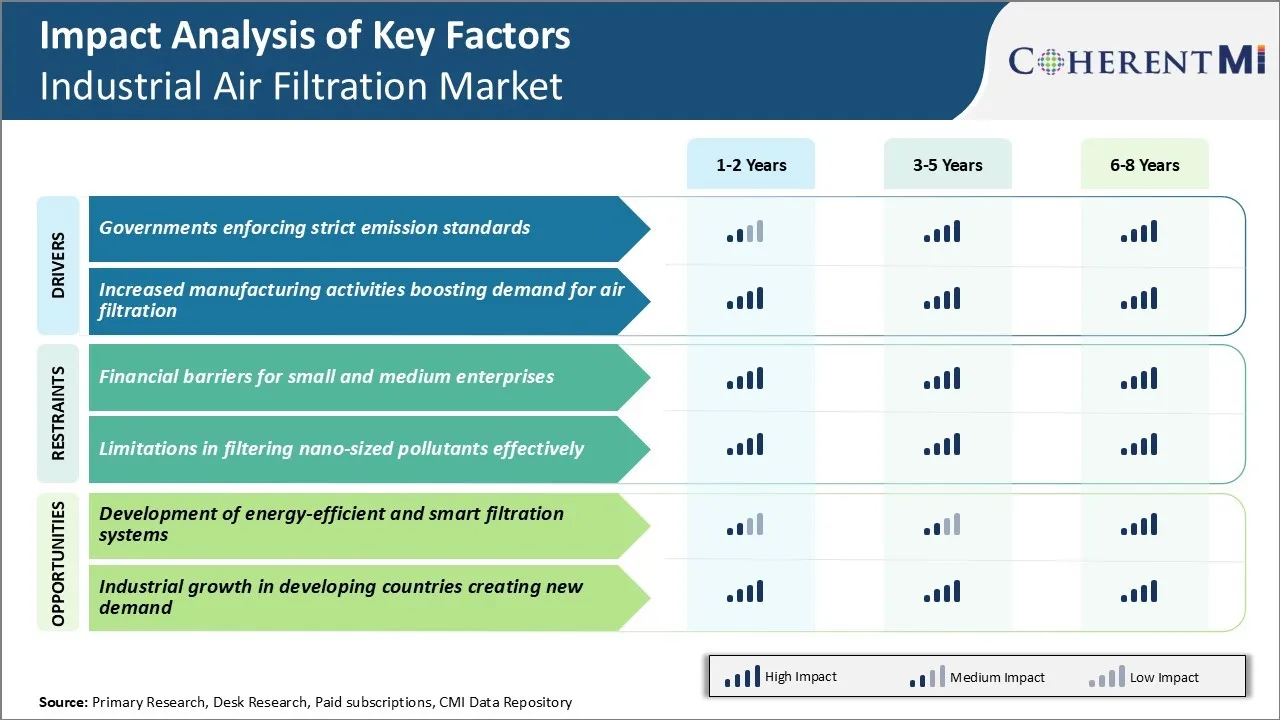Industrial Air Filtration Market Trends
Market Driver - Governments Enforcing Strict Emission Standards
With rising pollution levels across major industrial hubs, governments worldwide have started recognizing the grave risks posed by deteriorating air quality. Stricter norms and regulations around industrial emissions have been introduced to curb air and water pollution.
In North America, the Environmental Protection Agency has significantly lowered acceptable emission levels for a variety of pollutants. Strict compliance is being ensured through periodic audits and surprise inspections at factory premises. The penalties for non-compliance have also been ramped up.
The Euro emission standards for vehicles and industrial operations have become a lot more stringent with each iteration. The impending switch to Euro 7 regulations is keeping the automotive ancillary sector on its toes. The compliance burden along with looming fines for violation have boosted demand for relevant air filtration products and services.
Other major economies like China and India have also rolled out tighter ambient air quality standards in their industrial areas and special economic zones. This is an attempt to arrest the alarming levels of PM2.5 and PM10 that have severely affected public health. This bodes well for the industrial air filtration market.
Market Driver - Increased Manufacturing Activities Boosting Demand for Air Filtration
As industrialization picks up pace globally on the back of growing manufacturing capacities, the need for process air filtration rises substantially. Modern factories deploy sophisticated, automated machineries and equipment that generate fine particulates, mists, fumes, and other pollutants within closed work spaces. Unfiltered, these can seriously impact both industrial operations and occupational safety.
With rising production targets, the scale and output of industrial facilities has increased manifold. Greater amounts of pollutants are being released within industrial premises that necessitate strong air purification measures. Both new plants and existing factories are allocating larger CAPEX towards air filter retrofits and overhauls.
New-age sectors like renewable energy equipment, electric vehicles, aerospace and defense components require cleanroom environments to manufacture products. Only top-quality air scrubbing systems can sustain such pollution-sensitive operations on a large scale over the long-term. Therefore, the industrial air filtration market holds outstanding opportunities.
In summary, the global manufacturing sector is expanding at a fervent pace. This invariably increases the load of industrial pollutants that must be removed from circulating air through robust filtration arrangements. Such trends lay the foundation for continued growth of the industrial air filtration market.

Market Challenge - Financial Barriers for Small and Medium Enterprises
One of the key challenges for the industrial air filtration market is the financial barriers faced by small and medium enterprises (SMEs) for adoption of advanced air filtration systems. The initial capital costs associated with purchasing, installing, and commissioning industrial air filtration equipment can be quite high, ranging anywhere between $50,000 to $500,000. This significant upfront investment poses a major hurdle for SMEs who have limited capital budgets and restricted access to financing.
Unlike large enterprises, SMEs find it difficult to secure large loans or lines of credit from financing institutions. High interest rates on business loans in many countries additionally increase the costs. With thin profit margins, most SMEs are unable to justify such large capital expenditure on air filtration unless there is a compliance requirement. This financial challenge restricts their ability to invest in the latest industrial air filtration technologies meant for improving workplace air quality, reducing environmental emissions, and enhancing productivity.
Market Opportunity - Development of Energy-efficient and Smart Filtration Systems
One major opportunity for the industrial air filtration market lies in the development of sophisticated yet energy-efficient and smart filtration systems. The focus on reducing energy consumption and carbon footprint of industrial operations is growing, So, there is a growing need for filtration technologies that minimize operational costs while fulfilling stringent performance requirements.
Technologies such as energy recovery systems, variable speed fans, smart sensors, and IoT connectivity can help create a new generation of intelligent air filters optimized for low energy use. Integrating robotics, automation, predictive analytics and advanced materials can further boost the efficiency and lifespan of industrial air filtration systems.
The integration of renewable energy sources can make such systems self-sustaining with near-zero emissions. The development of user-friendly monitoring and reporting platforms can also unlock opportunities for advanced remote asset management. Energy-efficient, smart filters with predictive maintenance capabilities present enormous opportunities for industrial air filtration market players to be in line with the global move towards industry 4.0.